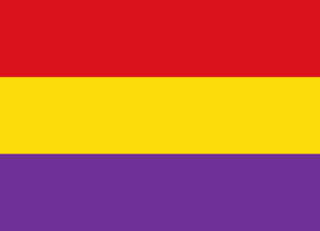
The International Brigades (IB) were volunteer military units of foreigners who fought on the side of the Second Spanish Republic during the Spanish Civil War. The number of combatant volunteers has been estimated at between 32,000–35,000, though with no more than about 20,000 active at any one time. A further 10,000 people probably participated in non-combatant roles and about 3,000–5,000 foreigners were members of CNT or POUM. They came from a claimed "53 nations" to fight against the Spanish Nationalist forces led by General Francisco Franco and assisted by German and Italian forces.

The Dimitrov Battalion was part of the International Brigades during the Spanish Civil War. It was the 18th battalion formed, and was named after Georgi Dimitrov, a Bulgarian communist and General Secretary of the Comintern in that period.

Mixed brigade was a basic tactical military unit of the Republican army during the Spanish Civil War. It was initially designed as "pocket division", an innovative maneuverable combined-arms formation. Because of high saturation with specialized troops and services it would have resembled a division, but in terms of manpower it would have been much smaller and amount to some 3,700 men.

The Second Mixed Brigade, was a mixed brigade of the Spanish Republican Army in the Spanish Civil War. It was formed in October 1936 as a result of the reorganization of the Spanish Republican Armed forces.

The 224th Mixed Brigade was a mixed brigade of the Spanish Republican Army in the Spanish Civil War. It was formed in summer 1937 in Catalonia from scattered Coastal Defence units and had four battalions: the 893, 894, 895 and 896.

The 227th Mixed Brigade, was a mixed brigade of the Spanish Republican Army in the Spanish Civil War. It was formed in the spring of 1938 in Catalonia and had four battalions, the 905, 906, 907 and 908.

The 26th Division was a division of the Spanish Republican Army in the Spanish Civil War. It was formed in April 1937 in Aragon from the militarized Columna Durruti during the reorganization of the Spanish Republican Armed Forces.

The 242nd Mixed Brigade, was a short-lived mixed brigade of the Spanish Republican Army in the Spanish Civil War.

The 228th Mixed Brigade, was a short-lived mixed brigade of the Spanish Republican Army in the Spanish Civil War. It was formed in the last months of the Civil War with battalions belonging to the Carabineros corps. Its first and only leader was the Carabineros Commander Miguel Bascuñana Sánchez.

The 3rd Mixed Brigade, was one of the earliest mixed brigades of the Spanish Republican Army in the Spanish Civil War. It was formed in the fall of 1936 with battalions of the Carabineros corps and saw major action right away in the Defence of Madrid. This brigade also included female combatants —such as Sergeant "La Chata"— and would take part in most of the major battles of the Spanish Civil War, except in the Battle of Jarama.

The 86th Mixed Brigade, was a mixed brigade of the Spanish Republican Army in the Spanish Civil War. It was formed in March 1937 with battalions of the Carabineros corps. Until its demise it operated mostly in the Sierra Morena area, at the southern limits of the territory held by the Republic.

The CL International Brigade or 150th International Brigade, also known as "Dabrowski Brigade", was a military unit of the International Brigades during the Spanish Civil War. Its members were mostly Polish, but there was also a Spanish battalion, as well as a Hungarian section.

The 45th Division was a division of the Spanish Republican Army in the Spanish Civil War.
The 153rd Mixed Brigade was a unit of the Spanish Civil War that took part in the Spanish Civil War. Formed around the old Land and Freedom Column, the unit took part in the battles of Belchite, Aragon and Segre.
The 140th Mixed Brigade was a unit of the Spanish Republican Army created during the Spanish Civil War. Throughout the war it operated on the fronts of Aragon, Segre, Ebro and Catalonia.
The 141st Mixed Brigade was a unit of the Spanish Republican Army during the Spanish Civil War. It participated in the Battle of Belchite, Aragon Offensive, Battle of the Segre and the Catalonia Offensive.
The 29th Division was a military formation belonging to the Spanish Republican Army that fought during the Spanish Civil War. Originally created in 1937 from the militarization of the POUM militia column, it was dissolved and recreated again in early 1938, operating on the Extremadura front.
The 104th Mixed Brigade was a unit of the Spanish Republican Army created during the Spanish Civil War. Throughout the war it acted on the Extremadura, Aragon and Catalonia fronts.
The 145th Mixed Brigade was a unit of the Spanish Republican Army created during the Spanish Civil War. Throughout the war, it operated on the Aragon, Segre and Catalonia fronts, although it did not play a relevant role.
The 149th Mixed Brigade was a unit of the Spanish Republican Army created during the Spanish Civil War. Deployed on the fronts of Madrid, Aragon and Catalonia, the brigade did not play a relevant role in the war.










